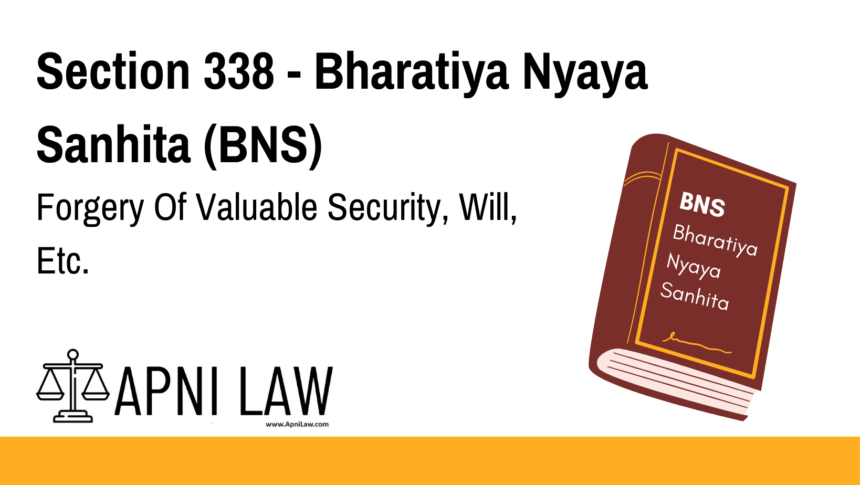Code: Section 338 BNS
Whoever forges a document which purports to be a valuable security or a will, or
an authority to adopt a son, or which purports to give authority to any person to make or
transfer any valuable security, or to receive the principal, interest or dividends thereon, or to
receive or deliver any money, movable property, or valuable security, or any document
purporting to be an acquittance or receipt acknowledging the payment of money, or an
acquittance or receipt for the delivery of any movable property or valuable security, shall be
punished with imprisonment for life, or with imprisonment of either description for a term
which may extend to ten years, and shall also be liable to fine.
Explanation of Section 338 BNS
Section 338 specifically targets the forgery of highly sensitive documents that can lead to significant financial, personal, or legal consequences. This includes:
- Valuable securities (like bonds, share certificates, etc.)
- Wills (which determine the distribution of a person’s estate after death)
- Adoption authorities (legal documents permitting adoption)
- Receipts and acquittances (acknowledgments of payments or deliveries)
Since these documents often involve large sums of money, property, or critical family decisions, forgery in these cases is treated with severe penalties, including life imprisonment in extreme cases.
Illustrations
- Forgery of a Will:
- Example: A forges a will to falsely claim the inheritance of a deceased person’s property.
- Outcome: A commits forgery under Section 338, punishable with up to 10 years of imprisonment and a fine.
- Forgery of Valuable Security:
- Example: B forges a bond to claim interest payments that don’t belong to them.
- Outcome: B commits forgery of a valuable security, liable for up to 10 years of imprisonment and fines.
- Fake Adoption Authority:
- Example: C forges an adoption authority document to illegally adopt a child without legal consent.
- Outcome: C commits forgery under Section 338, facing life imprisonment or up to 10 years in prison.
- Forgery of Acquittance:
- Example: D forges a receipt to claim that they received money from E, while in reality, no transaction occurred.
- Outcome: D commits forgery, punishable under Section 338.
- Forgery of a Receipt for Movable Property:
- Example: F forges a receipt claiming they delivered a car to G, but no such transaction happened.
- Outcome: F commits forgery under Section 338.
Common Questions and Answers
1. What types of documents are covered under Section 338?
It includes valuable securities, wills, adoption authorities, acquittances, receipts, and documents related to money, property, or legal authority.
2. What is the punishment for forgery under Section 338?
The punishment can be life imprisonment, or up to 10 years of imprisonment, along with a fine.
3. Does Section 338 cover both physical and electronic documents?
Yes, Section 338 applies to both physical and electronic documents, especially in the context of valuable securities and financial transactions.
4. Can someone be punished under Section 338 even if no financial loss occurred?
Yes, the intent to deceive or defraud is sufficient, even if no actual financial loss occurred.
5. How does Section 338 differ from Section 336?
- Section 336: Covers general forgery of documents with intent to defraud.
- Section 338: Focuses on forgery of documents that involve significant legal, financial, or personal stakes, with harsher punishments.
Conclusion
Section 338 of the Bharatiya Nyaya Sanhita (BNS) is designed to protect the integrity of critical documents that can affect an individual’s legal rights, financial standing, and personal relationships.
The severe punishments, including life imprisonment, reflect the seriousness of such crimes, as forgery in these areas can lead to significant economic losses, legal disputes, and social harm.
This section serves as a strong deterrent against individuals attempting to manipulate or falsify important documents, ensuring justice, fairness, and trust in legal and financial systems.











